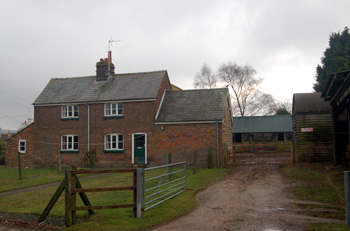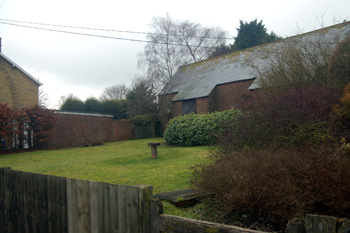Green Farm Totternhoe

Green Farm February 2010
Green Farm is a comparatively modern creation. In 1829, following the death of the Earl of Bridgewater, his estate in Totternhoe was surveyed [BW1004]. The survey also included every building in the parish, whether owned by the estate or not (and at that date most were not). The site of today's Green Farm was then occupied by two cottages, a yard, buildings, a garden and orchard, all owned by Thomas Turvey and occupied by William Inwood and John Puddephat as well as Turvey himself. The site measured two roods.
A similar survey was carried out in 1840 and at that date Turvey was still the owner. The tenants were described as Thomas Turvey "and another". The 1841 census reveals that Turvey himself lived in a property between Church Road and Furlong Lane. The two likely inhabitants of the cottages are the Inwards and Puddephatt families, as in 1829. William Inwards was about 35 and an agricultural labourer. His wife, Mary was about the same age and their children were Sarah, about 15 and Elizabeth, 10. John Puddephatt was about 50 and also an agricultural labourer. His wife Elizabeth was about the same age and their children were Hannah, about 15, Sarah and Levi, both 10.

The site of the first Primitive Methodist chapel February 2010
From 1861 to 1829 the first Primitive Methodist chapel in the village stood in what is now the garden of Green Farm. It lay just to the north of today's 4 Church Road and was demolished around 1929 because it was, by then, unsafe.
At some point it seems that Thomas Turvey or one of his successors in title sold the property to Lord of the Manor, Earl Brownlow because when the Earl sold his Totternhoe Estate in 1916 [AD1147/92] Lot 6 was "A Desriable Village Holding situate at Church End, including a Farmhouse and Capital Homestead, and having an area of about 1 acre, 2 roods, 23 poles". It was let to Charles Brinklow for £13 per annum. "The brick-built and slated FARMHOUSE contains on the GROUND FLOOR: - Two Sitting Rooms, brick-paved Kitchen and Pantry. On the UPPER FLOOR: - Two Bedrooms and Lumber Room. THE CAPITAL BUILDINGS include the following: - Barn with concrete floor. Range of Seven Pigsties, with ditto, Cow Shed for two, 3-bay open Cattle Shed, Cart Horse Stable for five, 4-bay open Cart and Implement Shed". Brinklow also leased most of five other pieces of land (Lots 6a to 6e) as follows:
- Lot 6a: 30 acres, 1 rood, 8 poles - "an important block of arable land" for £30 per annum;
- Lot 6b: "a similar lot" of 13 acres, 3 roods for £13/15/9 per annum;
- Lot 6c: "a useful block of arable land and grazing rights" - the latter (1 acre, 1 rood, 18 poles), were actually leased by G. E. Pratt, Brinklow having the remaining 30 acres, 1 rood for £30 per annum;
- Lot 6d: "a similar lot" - G. E. Pratt having 1 acre, 18 poles of regulated pasture whilst Brinklow had the remaining 21 acres, 3 roods, 4 poles of arable for £22 per annum;
- Lot 6e: "a valuable grazing field" of 4 acres, 3 roods, 3 poles for £6 per annum.
The land is annotated on the map accompanying the particulars and can be seen below. To see a larger version, please click on the image
![Green Farm Lands annotated on the 1916 sale particular [AD1147-92]](/CommunityHistories/Totternhoe/TotternhoeImages/Green Farm Lands annotated on the 1916 sale partic_350x192.jpg) Green Farm Lands annotated on the 1916 sale particular [AD1147-92]
Green Farm Lands annotated on the 1916 sale particular [AD1147-92]The Rating and Valuation Act 1925 stipulated that every piece of land and building in the country was to be assessed to determine its rateable value. Totternhoe, like much of Bedfordshire, was assessed in 1927 and at that date Green Farm was in the same ownership, and comprised part of, Church End Farm.